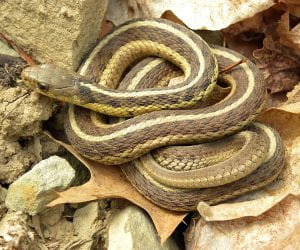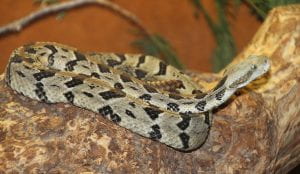With the warmth of spring and the heat of summer come a few trade-offs and one of them is snakes. Luckily, Delaware has only two commonly venomous snakes, the copperhead and the timber rattlesnake, both considered pit vipers. The common garter snake is considered mildly venomous. There are a dozen or more other snakes in Delaware, generally considered to be clinically nonvenomous (i.e., not clinically significant to most people).
Western movies and comedy routines would have us think that people die of snakebites frequently. But the Centers for Disease Control indicates that 7,000–8,000 people per year receive venomous bites across the United States, and only about 5 of those people die. Nevertheless, although rare, those with a severe allergy to snake venom may be at risk of death if bitten. The number of deaths would be much higher if people did not seek medical care.
Non-venomous snakes, generally, can still bite, and while the risk of death is no longer a typical threat, the bite itself can be quite painful, and other complications can result.
So, it is important to train workers about the risk of exposure to venomous and nonvenomous snakes, how they can prevent and protect themselves from snakebites, and what they should do if they are bitten.
First, try to avoid getting bitten. As with some of the other dangers we face, the first best practice is to know your surroundings and know your risk. Before moving piles of rocks, leaves, wood, debris, etc. think about what might be lurking within or beneath. Where practical, use tools like shovels and rakes to move the materials before picking them up. Wear boots and gloves, if just to deflect a striking snake.
What to do if bitten:
- Remain calm – death from most snakebites is not instantaneous.
- Avoid the snake – it can re-strike with more venom.
- Observe what you can about the snake from a distance to assist the medical team – take a photo from a safe distance.
- Apply a splint to the bitten limb to restrict muscle contraction.
- Notify your supervisor.
- GO IMMEDIATELY TO THE HOSPITAL.
- Avoid anything that thins your blood or accelerates your heart rate: alcohol, cigarettes, aspirin, etc.
What NOT to do if bitten:
- Don’t wait for symptoms to appear.
- Don’t apply a tourniquet.
- Don’t cut the wound with a knife or attempt to suck out the venom.
- Don’t apply ice or immerse the wound in water.
Employers should dedicate a tailgate safety meeting to snake awareness, posting pictures of common snakes, discussing good practices to avoid them, and what to do if a bite does happen.
Like many other safety threats we face, good boots, leather gloves, and a keen awareness of our surroundings can go a long way towards avoiding a snakebite, venomous or otherwise.
Information resources:
- Centers for Disease Control – http://www.cdc.gov/niosh/topics/snakes/default.html
- OSHA Quick Card https://www.osha.gov/OshDoc/data_Hurricane_Facts/rodents_snakes_insects.pdf
Note- this article inspired by the West Virginia LTAP
Photo Credit: Creative Commons





You must be logged in to post a comment.